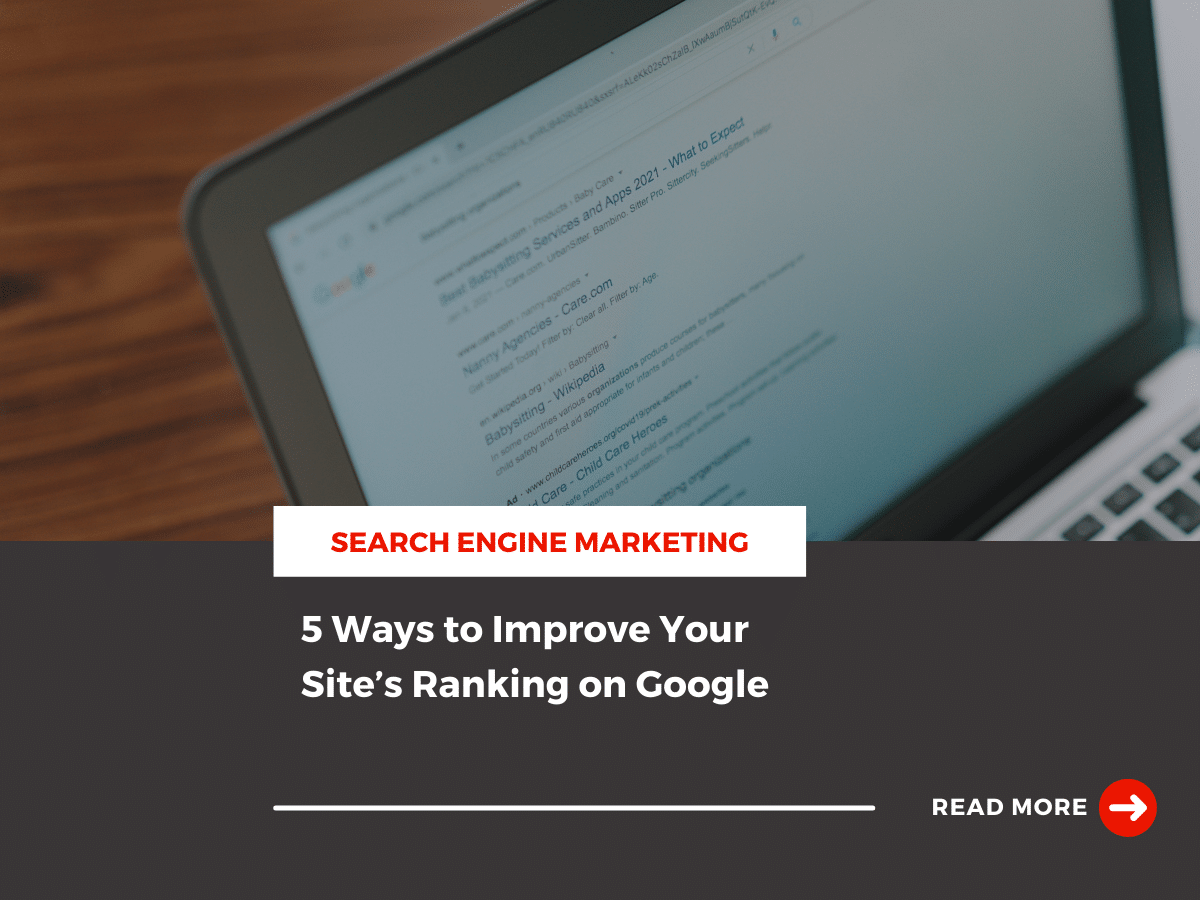Tired of seeing your competitors outrank you on Google? Wish there was a way you can move your website from the second page of results to the first? The answer is search engine optimization.
How high your site ranks on the search engine results page is one of the most essential parts of an SEO strategy. The higher you rank, the more traffic you can bring to your website. However, it’s not always as easy as it seems. Google has over 200 ranking factors, and many factors are not released to the public.
As a marketing professional, there are steps you can take to improve the quality of your content and fine-tune your approach to SEO to meet the needs of the biggest search engine in the world.
We’re here to walk you through 5 ways to improve your Google rankings.
Here’s everything you need to know:
Why Does Search Engine Ranking Matter?
Put yourself in your consumer’s shoes. When you go to Google to search for a product or service, which link do you click? How many search results pages do you flip through before you find what you’re looking for? Chances are, you click one of the links in the first three positions and then continue your shopping experience. It’s unlikely that you venture to the second or third page of results daily (or even at all.)
If you want to grow or scale your business, you need to scale your SEO strategy to meet the needs of the search engine. Because if your brand isn’t landing on the first page of results, you may never get seen by your target audience.
5 Ways to Improve Your Google Ranking
1. Keyword Research
Keywords are the driving force for every SEO strategy. If you aren’t targeting the right keywords, you aren’t getting your products or services in front of the right audience. To ensure you’re reaching your full potential and your content is ranking for words that will garner the highest results, you’ll need to conduct keyword research and thorough keyword analysis to find your opportunities and challenges.
Here’s how to get started:
- Understand your audience’s search intent
- Make a list of high-search volume keywords
- Assess the competition
- Look for low-competition keywords
- Include a mix of head and long tail keywords into your strategy
Ranking for popular keywords is more challenging than it might appear. For example, if you own a surfboard shop, you’ll struggle to rank for the word surfboards when your competitors are Amazon, Youtube, and other well-known established domains. Instead, you may use a long tail keyword like a surfboard shop in California or custom surfboards near you. While these words may have a lower search volume than a surfboard, they can be easier to rank for and more beneficial to your strategy in the long run.
Once you’ve conducted keyword research, you can use your findings to develop a content strategy or optimize the current content already on your website.
2. On-Page Optimization
On-page optimization refers to the process of updating the SEO elements so that your content is easily discoverable by search engines and website visitors.
Here’s a list of SEO elements you’ll want to consider:
- Page titles
- Header tags
- Keyword density
- Meta description
- Title tags
- Internal links and anchor text
- E-A-T signals
For the best results, you should optimize your on-page elements regularly, at least once every quarter.
3. Link Building
Link building is vital to building your domain authority. Think of backlinks as signals that tell search engines your website is a trusted voice and resource. When you have backlinks on trustworthy websites, it tells search engines that you’re a leader in the industry, which will help you earn higher rankings.
There are a few natural ways to build backlinks. Here are a few you can consider incorporating into your marketing strategy:
- Create shareable content like infographics, images, and videos
- Create free tools and how-to guides
- Update your old content regularly
To find other backlink opportunities, consider working with a Digital PR or marketing agency that can help you land guest blogs and placements.
You’ll also want to take some time to eliminate any broken links that lead to 404 error pages. If you find a broken backlink, you can connect with the website to replace the link with your website or content. Get creative and think outside of the box! The more backlinks you gain, the higher you’ll move on to the SERPs.
4. Mobile Optimization
If your website isn’t optimized for mobile devices, you aren’t providing the best possible experience for over half of your audience. It’s estimated there are over 4.32 billion active mobile internet users. Mobile-friendly websites meet the needs of their customers and provide the best possible user experience. You want to ensure that when a user lands on your website from a mobile device, they are given the same or similar experience as a desktop user. Here’s what you can do to ensure your website is mobile-friendly.
- Have a responsive layout
- Optimize your website speed
- Make sure all fonts, text, and colors you use are readable and don’t distract from the experience
- Test regularly on a desktop and mobile device
- Consider turning pop-ups off for mobile website visitors
We only expect the number of mobile internet users to steadily increase over the next few years. As a business, it’s best to always consider both audiences are getting the best possible experience.
5. Content Creation
The content you create is the driving force for your search engine ranking. Google prioritizes content that aligns with E-E-A-T. E-E-A-T is Google’s acronym that stands for experience, expertise, authoritativeness, and trustworthiness.
Google has search quality rater guidelines you can follow to ensure your content meets your audience’s needs and is useful for your target audience.
When optimizing your website’s content, you’ll want to make sure your content is useful, valuable, and engaging. You want to ensure you create content for humans, not a search engine. This means your content should aim to solve your audience’s problem and shouldn’t be written just to rank higher in the SERPs.
Here are a few tips to consider to make sure your content meets the needs of your audience:
- Include an FAQ section
- Make sure all keywords flow naturally throughout the content
- Keep your content on-brand and make sure it meets the needs of your audience
- Make sure your internal linking makes sense
- Ensure your content is Expertise, Authoritativeness, and Trustworthiness
How Long Does It Take for Google To Rank Your Content?
This will depend on how new your domain is and how much time you put into your content ranking strategy. If you’re starting from scratch, it may take anywhere from three to six months to rank on the first page of the results page. However, some brands see success as soon as one or two months.
Improve Your Site’s Ranking With Kanbar Digital
Improving your ranking on Google takes time. If you want to rank higher in the SERPs, you’ll need to dedicate your time and energy to fine-tuning your approach to SEO every day. At Kanbar Digital, we take the stress out of improving your website rankings. We work with businesses of every size across many industries, so you can feel confident that we can help you improve your SEO strategy and slowly grow your rankings in the SERPs.




